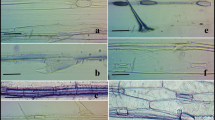Abstract
Silicon is an essential element for the growth and development of bamboo plants that significantly affects the biochemical and physical properties for industrialized bamboo utilization. Silicon is biomineralized as diverse forms of phytoliths in the bamboo organs. We investigated the silicon variation and phytolith morphology in different organs of Dendrocalamus brandisii (Munro) Kurz. The silicon content in D. brandisii (Munro) Kurz varies and increases in the order of leaf > sheath > branch > culm > shoot > root. The phytolith morphotypes and presence frequency in different D. brandisii organs varied closely interrelated with the cell structure and organ functions. Amorphous silicon deposition and few varieties and numbers of phytolith were found in D. brandisii root and shoots. Rich distribution of the saddle and dumb-bell phytoliths was found in all organs except the root and mature culm and branch. More elongate and rectangular phytoliths were found in mature culm and branch. Round and elliptical phytoliths might be firstly formed followed by dumb-bell and saddle phytoliths. Phytolith sizes increased with increasing culm, branch and leaf age, but did not demonstrate a specific trend with culm height. The result could contribute to enriching phytolith morphology in Gramineae and provide theoretical basis and references for plant taxonomy and large-scale bamboo industrial processing and utilization.









Similar content being viewed by others
References
Brown DA (1984) Prospects and limits of a phytolith key for grasses in the central United States. J Archaeol Sci 11:345–368
Chen CB, Ni B, Xu SP (2003) Morphology and morphogenesis of silica bodies in Bambusa multiplex var. nana. Bull Bot Res 23:424–428
Ding TP, Zhou JX, Wan DF, Chen ZY, Wang CY, Zhang F (2009) Silicon isotope fractionation in bamboo and its significance to the biogeochemical cycle of silicon. Geochim Cosmochim Acta 72:1381–1395
Gallego L, Distel RA (2004) Phytolith assemblages in grasses native to central Argentina. Ann Bot 94:865–874
Gu Y, Zhao Z, Pearsall DM (2013) Phytolith morphology research on wild and domesticated rice species in East Asia. Quat Int 287:141–148
Gu Y, Liu H, Wang H, Li R, Yu J (2016) Phytoliths as a method of identification for three genera of woody bamboos (Bambusoideae) in tropical southwest China. J Archaeol Sci 68:46–53
Li Q, Xu D, Lu H (2005) Morphology of phytolith in Bambusoideae (Poaceae) and its ecological significance. Quat Sci 25:777–784
Li X, Shupe TF, Peter GF, Hse CY, Eberhardt TL (2007) Chemical changes with maturation of the bamboo species Phyllostachys pubescens. J Trop For Sci 19:6–12
Lux A, Luxová M, Abe J, Morita S, Inanaga S (2003) Silicification of bamboo (Phyllostachys heterocycla Mitf.) root and leaf. Plant Soil 255:85–91
Ma JF, Yamaji N (2006) Silicon uptake and accumulation in higher plants. Trends Plant Sci 11:392–397
Ma JF, Yamaji N (2008) Functions and transport of silicon in plants. Cell Mol Life Sci 65:3049–3057
Madella M, Alexandre A, Ball T (2005) International code for phytolith nomenclature 1.0. Ann Bot 96:253–260
Motomura H, Mita N, Suzuki M (2002) Silica accumulation in long-lived leaves of Sasa veitchii (Carrière) Rehder (Poaceae-Bambusoideae). Ann Bot 90:149–152
Pearsall DM (2000) Paleoethnobotany: a handbook of procedures. Academic Press, San Diego
Piperno DR (1988) Phytolith analysis—an archeological and geological perspective. Academic Press, San Diego
Piperno DR (2006) Phytoliths: a comprehensive guide to archaeologists and palaeoecologists. Altamira Press, Lanham
Rovner I (1983) Plant opal phytolith analysis: major advances in archaeobotanical research. Adv Archaeol Method Theory 6:225–266
Schaller J, Brackhage C, Paasch S, Brunner E, Bäucker E, Dudel EG (2013) Silica uptake from nanoparticles and silica condensation state in different tissues of Phragmites australis. Sci Total Environ 442:6–9
Twiss PC, Suess E, Smith RM (1969) Morphological classification of grass phytoliths. Soil Sci Soc Am J 33:109–114
Wang Y, Lu H (1993) Phytolith study and its application. China Ocean Press, Beijing
Wang Y, Zhan H, Ding Y, Wang S, Lin S (2016) Variability of anatomical and chemical properties with age and height in Dendrocalamus brandisii. BioResources 11:1202–1213
Xing X, Zhang L (1998) Review of silicon nutrition in plants. Chin Bull Bot 15:33–40
Yang Y, Wang K, Wang J (2018) Bamboo flora of Yunnan. Yunnan Press, Kunming
Zhan H, Tang G, Wang C, Wang S (2015) Chemical properties and fibers morphology of Fargesia fungosa at different culm ages and heights. BioResources 10:5666–5676
Zhan H, Zhao J, Li M, Wang C, Wang S (2017) Anatomical and chemical properties of bamboo sheaths (Dendrocalamus brandisii) as potential raw materials for paper making. Eur J Wood Wood Prod 75:847–851
Zou Q (2008) Experiment instruction of plant physiology. China Agricultural Press, Beijing
Acknowledgements
This work was jointly supported by Yunnan Provincial Joint Special Project for Basic Research in Agriculture (No. 2017FG001-092); Scientific Research Start-up Fund Project of Southwest Forestry University (No. 111817); National Science Foundation of China (Nos. 31460169, 31560196, 31800506).
Author information
Authors and Affiliations
Contributions
HZ was involved in designing the experiment, running the data analysis and writing the paper. LJ performed data gathering and comments on manuscript. ZN contributed to data gathering designed the experiment. ML performed revising and comments on manuscript. CW was involved in data gathering and comments on manuscript. SW designed the experiment, coordinated and supervised the research work and revised the manuscript.
Corresponding authors
Ethics declarations
Conflict of interest
The authors declare that they have no conflicts of interest.
Additional information
Publisher's Note
Springer Nature remains neutral with regard to jurisdictional claims in published maps and institutional affiliations.
Rights and permissions
About this article
Cite this article
Zhan, H., Juan, L., Zhao-hui, N. et al. Silicon variation and phytolith morphology in different organs of Dendrocalamus brandisii (Munro) Kurz (Bambusoideae). Braz. J. Bot 42, 529–541 (2019). https://doi.org/10.1007/s40415-019-00554-x
Received:
Revised:
Accepted:
Published:
Issue Date:
DOI: https://doi.org/10.1007/s40415-019-00554-x




